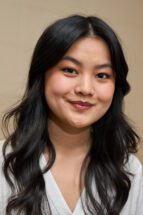Scout Hamrick has spent time in two different scientific epicenters: the Clemson University College of Science and the “Hawkins National Laboratory.”
Hamrick is not only a senior working in the lab of Julia Brumaghim, a professor in the Department of Chemistry, but also an actress who appeared in season four of “Stranger Things,” a Netflix series that mixes horror, drama, science fiction and coming of age.

“I got to work with some cool people, and seeing how a set works and things like that was really cool. And they gave me a trailer and signed me for a second episode on that day,” Hamrick said.
Hamrick started acting when she was 5. At 15, she received a callback audition for a part in “Stranger Things” and then filmed two episodes.
Through her research, she’s found it’s not just the Upside Down where radiation can have drastic implications. (For those who don’t watch “Stranger Things,” the Upside Down is a hostile alternate dimension).
She works with Brumaghim on a project examining how space radiation damages DNA and testing radioprotectants to prevent this damage.
In past research projects, testing different compounds for damage prevention from radiation took a lot of time and effort. Hamrick has been developing a new assay that speeds up the process.
Testing compounds for damage prevention previously involved growing and maintaining cells, extracting DNA and running gels to visualize results. The procedure takes days. Hamrick and other researchers in Brumaghim’s lab streamlined the process to about three hours with their assay.
The assay uses deoxyribose, the sugar molecule that makes up DNA, as a control and ultraviolet spectroscopy to quantify deoxyribose damage due to radiation. Hamrick tests their new assay by comparing their results to those collected from the prior methods.
The assay tests how deoxyribose responds to radiation under certain conditions. Usually, radiation puts oxidative stress on cells, leading to single and double-strand breaks and mutations in the cell’s DNA. Hamrick treats deoxyribose with polyphenols, a natural antioxidant prevalent in certain foods like fruit, to see whether different polyphenols minimize or prevent damage if the deoxyribose is subjected to radiation.
Polyphenols mitigate DNA damage through their chemical structure, which deprotonates or becomes more negative in aqueous environments. This deprotonation allows polyphenols to pick up free radicals such as radiation and alleviate the stress on DNA.

Radiation
The lab also collaborates with the Department of Physics and Astronomy to use their Electron Beam Ion Trap (EBIT), which exposes the assay to extreme radiation levels to test how deoxyribose is sustained in extreme environments. The EBIT has previously been used only with solid materials, but the new assay is aqueous, so the lab adapts and reengineers.
Hamrick joined this project because of the applications of radiotherapy as a cancer treatment. Radiation therapy has come a long way and can radiate accurately and precisely, but the healthy cells in the surrounding area of cancerous cells are still at risk, she said. That’s where antioxidants like polyphenols come into play as a potential solution to protect healthy cells during radiotherapy treatments.
The lab received a grant from NASA due to another future implication of the project: space travel. Radioactive environments in space put astronauts at risk for cell death and damage, she said. Protective antioxidants and quicker testing of radiation damage could aid long-term space travel endeavors and research.
Gap year
After graduating in May 2025, completing her degree in three years, Hamrick plans to take a gap year and work in the medical field while applying to medical school, where she hopes to train as a surgeon. During her gap year, she plans to pursue acting opportunities along with working a clinical job.
Hamrick, a bioengineering major with minors in chemistry and materials science and engineering, sees a different side of the medical field through her major. Her studies have taken her beyond simply seeing medical products’ use but also the thought and design process behind developing these products. She’s witnessed the extensive undertaking for product approval for use in hospitals or for the public. “It’s given me a well-rounded idea of how the whole system works,” Hamrick says.
Hamrick is a member of the pre-medical fraternity Phi Delta Epsilon and participates in Clemson Medical Education Development (CMED), where she gets to shadow different doctors and tutors for Clemson’s Peer & Wise program.
Get in touch and we will connect you with the author or another expert.
Or email us at news@clemson.edu

